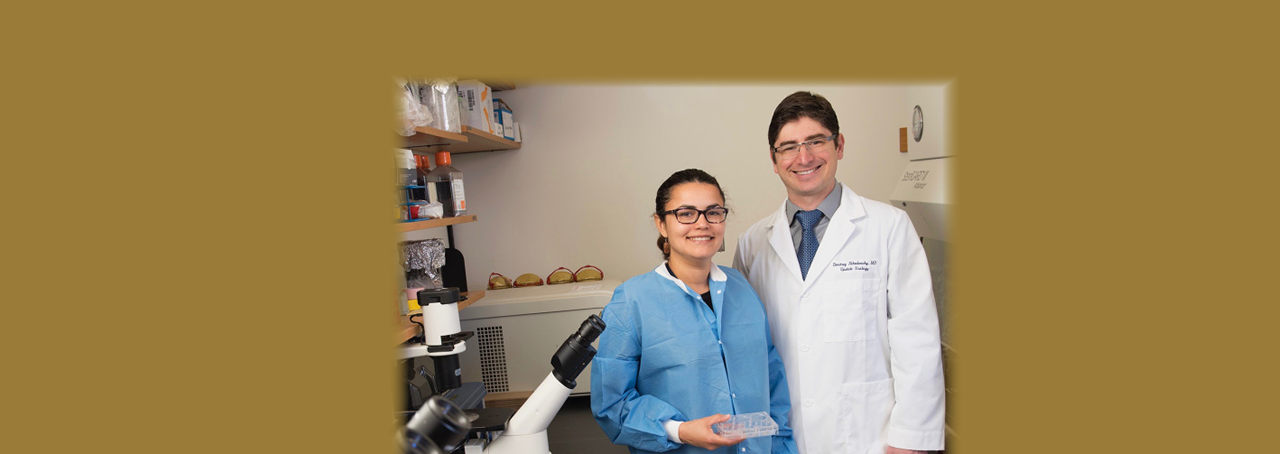Open wide and say ‘aha!’
By Amber Smith, Upstate Medical University
Only an innovative scientist with expertise in reconstructive urology would look at the inside lining of the cheek and wonder how those cells would behave if transplanted into the urethra, the tube that carries urine from the bladder.
Dmitriy Nikolavsky, MD, is that urologic scientist.
As director of reconstructive urology at Upstate University Hospital, Nikolavsky has completed more than 250 urethral reconstructions over the past four years. Many of the reconstructions were necessary because of patients with urethral strictures, a narrowing of the urethra with a variety of causes, including inflammation, infection, injury and previous surgeries or catheterizations.
He’s on a quest to find solutions for these patients. He earned a “Young Investigator” grant this year from the northeastern section of the American Urologic Association. And in May the Journal of Urology chose his research paper as best paper in investigative urology in 2016.
Spray paint or wallpaper?
Among the traditional treatments for urethral stricture are a urethral dilation meant to stretch scar tissue without injuring the lining of the urethra, or an endoscopic procedure that involves internal cutting to widen the urethra, called a urethrotomy. These procedures often do not provide lasting relief.
An open surgery called urethroplasty has a better success rate, but not many urologists have the proficiency to offer it as an option to patients.
Nikolavsky says the success of urethroplasty can be improved with the use of a buccal mucosa graft, which many reconstructive urologists have used for several decades. That’s where the surgeon cuts a section of tissue from the patient’s inner cheek and transplants it like wallpaper onto the inside of the urethra.
Tissue from inside the mouth is a natural substitute for urethral tissue because both are from wet, hairless environments, and because surgeons can easily access the inside of the mouth. Also, the inside of the cheek typically heals quickly, similar to the way a pizza burn wound heal.
Unfortunately, transplanting tissue directly from the mouth and onto the urethral defect requires an open surgery that is technically difficult and not widely available from all urologists.
So, Nikolavsky is experimenting with a couple of ways to complete a two-step process that he hopes will become a feasible alternative option. Instead of a surgeon “wallpapering” the damaged area of the urethra with buccal mucosa in an open surgery, Nikolavsky wants to be able to “spray-paint” a buccal mucosa solution through an endoscope, a tubular instrument.
Here’s how it might work:
In one version, the tissue could be removed from the patient’s mouth and immediately processed into a liquid. Then, the urologist could place a catheter (tube) in the urethra, and the liquid buccal mucosa would be injected around the catheter. The catheter would stay in place for a week, until the urethra heals.
Another method Nikolavsky is exploring would remove the tissue from the patient’s mouth and send it to a laboratory. Fragments of the buccal mucosa would become part of a liquid solution containing a fibrin glue, designed to help the solution adhere to the damaged area of the urethra. The patient would return another day for the second step, in which the liquid graft would be added to the urethra through an endoscope.
“Buccal mucosal cells have increased metabolism and contain numerous fibroblast and epithelial progenitor cells with stem cell properties,” which means they are ideal to help with wound-healing, Nikolavsky and colleagues describe in the Journal of Urology in 2016.
Urologists are not the only ones excited about the potential of buccal mucosa grafts. Scientists studying regenerative medicine are looking at such grafts for use in reconstruction of the cornea, esophageal (food pipe) strictures and skin burns.
comments powered by Disqus


